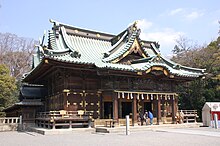Mishima, Shizuoka



Mishima (三島市, Mishima-shi) is a city located in eastern Shizuoka Prefecture, Japan. As of 2009, the city has an estimated population of 112,078 and a density of 1,800 persons per km². The total area is 62.13 km². Its population has expanded since the opening of the Tōkaidō Shinkansen line made it possible to commute to Tokyo.
Novelist Kimitake Hiraoka adopted his penname Yukio Mishima after the city.
Geography
Mishima is located in far eastern Shizuoka Prefecture, at the top of Izu Peninsula and in the foothills of Mount Fuji. The area has a temperate martitime climate with hot, humid summers and cool, mild winters.
Surrounding municipalities
Shizuoka Prefecture
Kanagawa Prefecture
History
Mishima is an ancient town, which developed around the important Shinto shrine of Mishima Shrine (三嶋大社, Mishima Taisha). Under the Ritsuryo administration system established in the Nara period, Mishima was made capital of Izu Province. It was also the location of the Kokubun-ji for Izu Province. In the Edo period, Mishima prospered from its location on the Tōkaidō highway connecting Edo with Kyoto, and Mishima-shuku was one of the 53 post stations on that road. The area was tenryō territory ruled by a daikan appointed directly by the Tokugawa shogunate. After the Meiji Restoration, Mishima became part of the short-lived Nirayama Prefecture in 1868. This merged with the equally short-lived Ashigara Prefecture in 1871, and became part of Shizuoka Prefecture from April 18, 1876. During the cadastral reform of 1889, the area was reorganized as Mishimi Town within Kimisawa District. In 1892, Prince Komatsu Akihito established a villa in Mishima. Its gardens, the Rakujūen, are a noted visitor attraction in Mishima to this day. In 1896, Kimisawa District became part of Tagata District, Shizuoka. Mishima received its first train connection in 1898 when the predecessor of the Izuhakone Railway established what is now Shimo-Togari Station. The Sunzu Line began operations from 1906. However, Mishima's fortunes revived strongly only after the Tanna Tunnel was completed in 1934, connecting the town to the Tōkaidō Main Line railway between Tokyo and Shizuoka. Mishima developed rapidly afterwards, merging with neighboring Kitakami Village in 1935 and Watada Village in 1941. Mishima Town was elevated in status to a city on April 29, 1941. It became a stop on the Tōkaidō Shinkansen from 1969. Mishima is home to a Rinzai Zen temple of some importance, Ryūtaku-ji.
Economy
Mishima is a major industrial center within Shizuoka Prefecture. In addition to a railroad repair facility operated by JR Tōkai, the city hosts factories from:
- Toray
- DMW Corporation
- Toshiba TEC Corporation
- Yokohama Rubber Company
- CFS Corporation (HAC Drugstores)
- Izuhakone Railway Company Ltd
Sister City relations
 Pasadena, California, United States, since July 24, 1957
Pasadena, California, United States, since July 24, 1957 New Plymouth, New Zealand, since April 29, 1991
New Plymouth, New Zealand, since April 29, 1991 Lishui, China since May 12, 1997
Lishui, China since May 12, 1997
Transport
Railway
- JR Tōkai - Tōkaidō Shinkansen
- JR Tōkai - Tōkaidō Main Line
- Mishima Station
- Izuhakone Railway - Sunzu Line
- Mishima - Mishima-Hirokōji - Mishima-Tamachi - Mishima-Futsukamachi - Shizuoka
Highway
Education
The College of International Relations for Nihon University is located in Mishima. It provides opportunities for international students to live in Mishima and explore Japanese culture. Mishima is also home to the National Institute of Genetics (国立遺伝学研究所), which also provides graduate education as the department of genetics of the national university SOKENDAI - the Graduate University for Advanced Studies (総合研究大学大学院).
Culture
The Mishima Summer Festival takes place from August 15 to 17 every year, in and around the Mishima Taisha shrine, as well as near the Mishima Station. Mikoshi are carried through the streets and the taiko are played.
Through Rakujuen, a park central to the image of Mishima, the city's calm nature can be seen.
Noted people from Mishima
- Makoto Ooka - poet and literary critic
- Yukiko Sakamoto - politician
- Naohiro Takahara - professional soccer player
External links
- Mishima official website in Japanese
